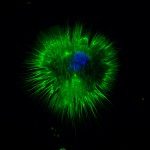Link to Pubmed [PMID] – 21269513
BMC Genomics 2011 Jan;12:71
BACKGROUND: Segmental duplications (SDs) on 22q11.2 (LCR22), serve as substrates for meiotic non-allelic homologous recombination (NAHR) events resulting in several clinically significant genomic disorders.
RESULTS: To understand the duplication activity leading to the complicated SD structure of this region, we have applied the A-Bruijn graph algorithm to decompose the 22q11.2 SDs to 523 fundamental duplication sequences, termed subunits. Cross-species syntenic analysis of primate genomes demonstrates that many of these LCR22 subunits emerged very recently, especially those implicated in human genomic disorders. Some subunits have expanded more actively than others, and young Alu SINEs, are associated much more frequently with duplicated sequences that have undergone active expansion, confirming their role in mediating recombination events. Many copy number variations (CNVs) exist on 22q11.2, some flanked by SDs. Interestingly, two chromosome breakpoints for 13 CNVs (mean length 65 kb) are located in paralogous subunits, providing direct evidence that SD subunits could contribute to CNV formation. Sequence analysis of PACs or BACs identified extra CNVs, specifically, 10 insertions and 18 deletions within 22q11.2; four were more than 10 kb in size and most contained young AluYs at their breakpoints.
CONCLUSIONS: Our study indicates that AluYs are implicated in the past and current duplication events, and moreover suggests that DNA rearrangements in 22q11.2 genomic disorders perhaps do not occur randomly but involve both actively expanded duplication subunits and Alu elements.

